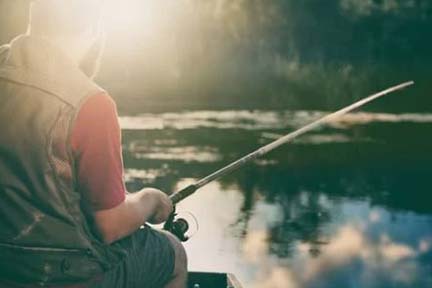
by orionontv | Jun 5, 2024 | Recreation
|
|
 |
DNR News
|
|
June 4, 2024
Contact: Ron Yesney (ORV), 906-228-6551; Randy Claramunt (fishing), 231-622-3820 or Ron Olson (Recreation Passport), 517-243-1477
Free fishing, off-roading and state park entry – enjoy it all during Michigan’s ‘Three Free’ Weekend June 8-9
 The Michigan Department of Natural Resources encourages everyone to take advantage of “Three Free” Weekend – Saturday, June 8, and Sunday, June 9. It’s two full days when Michigan residents and out-of-state visitors can grab a fishing rod, ride the off-road trails and visit state parks, boating access sites and other outdoor locations — all free of charge. The Michigan Department of Natural Resources encourages everyone to take advantage of “Three Free” Weekend – Saturday, June 8, and Sunday, June 9. It’s two full days when Michigan residents and out-of-state visitors can grab a fishing rod, ride the off-road trails and visit state parks, boating access sites and other outdoor locations — all free of charge.
“We’re excited to celebrate ‘Three Free’ Weekend, a time when everyone gets to enjoy and take part in some of Michigan’s best outdoor recreation opportunities: fishing, off-roading and exploring Michigan’s award-winning state parks,” said DNR Director Scott Bowen. “Whether you’re an avid outdoors-person or someone just discovering all that our beautiful state offers, ‘Three Free’ weekends make it easy to visit a new park, try a new nature experience or spend time with friends and family in a place you love.” |
 These two days include: These two days include:
- Free Fishing Weekend. Fish for all in-season species, all weekend long, without a license. All other fishing regulations apply. To get more details or find a local event, visit Michigan.gov/FreeFishing.
- Free ORV Weekend. Legally ride 4,000 miles of state-designated routes and trails and the state’s six scramble areas without purchasing an ORV license or trail permit. Visit Michigan.gov/ORVinfo for the latest ORV trail, safety and closure information.
- Waiver of the Recreation Passport. To encourage people to pursue free fishing and other outdoor fun, the DNR waives the regular Recreation Passport fee that grants vehicle access to Michigan’s 103 state parks, 1,000-plus state-managed boating access sites and many other outdoor spaces. Learn more about Passport benefits at Michigan.gov/RecreationPassport.
Free Fishing and Free ORV weekends each take place on back-to-back days twice a year, but the “Three Free” Weekend happens only in June. |
Protect yourself and the outdoors
 For the best outdoor experiences, the DNR urges everyone to put safety first when enjoying Michigan’s woods, water and trails. For the best outdoor experiences, the DNR urges everyone to put safety first when enjoying Michigan’s woods, water and trails.
- Helpful safety tips – for ORV, boating, beach, fire and other topics – are available at Michigan.gov/DNREducation in the Safety Information section. Please pay special attention to fire safety at Michigan.gov/PreventWildfires.
- Trail users can do their part for invasive species prevention by removing dirt and debris from shoes, gear and vehicles before heading to the next location. Other easy ways to help include committing to Ride Right and following simple trail etiquette.
- Boaters can help prevent the spread of invasive species by removing mud and debris from all surfaces, draining water from all bilges, wells and tanks, and drying all equipment before transporting boats over land.
- The DNR also encourages anglers to review fishing safety tips and other helpful information at Michigan.gov/HowToFish.
Additionally, the DNR encourages everyone to #RecreateResponsibly. Before you head out on the trails or water, visit our Recreate Responsibly webpage to learn more about how you can stay safe and protect the health and beauty of our great state. |
Note to editors: Accompanying photos are available below for download. Caption information follows.
|
|
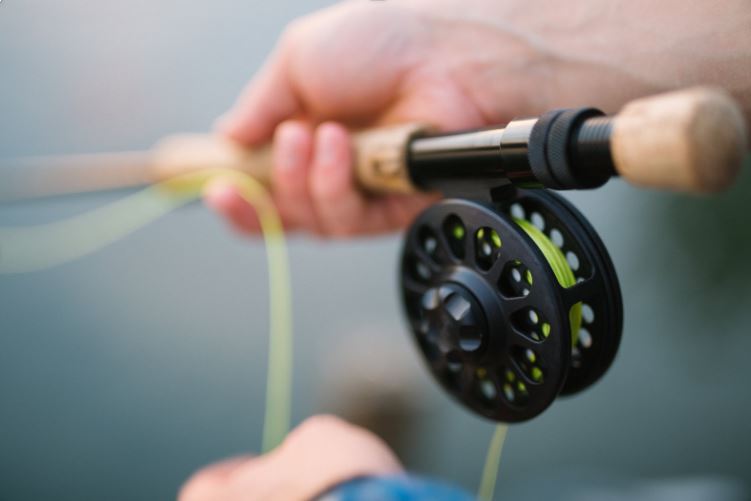
by orionontv | Jun 3, 2024 | Recreation
Free ORV, Fishing Weekend
The Michigan Department of Natural Resources (MDNR) is hosting a Free ORV and Summer Free Fishing Weekend June 8-9 and there are plenty of opportunities to join in these fun activities at Oakland County Parks (OCP).
Oakland County Parks offers close-to-home fishing at seven parks: Addison Oaks near Rochester, Groveland Oaks in Holly, Highland Oaks in Highland, Independence Oaks in Clarkston, Orion Oaks in Orion, Pontiac Oaks in Pontiac and Rose Oaks in Holly. Participants will need a daily park pass or a vehicle permit for entry at these parks except for Pontiac Oaks. View a Map of Fishing Opportunities in Oakland County Parks.
Holly Oaks ORV Park is also participating in the Free ORV Weekend. During these two days, Michigan residents and visitors can legally ride DNR-designated routes and trails without purchasing an ORV license or trail permit. The entrance fee for Holly Oaks ORV Park has been waived by the Oakland County Parks and Recreation Commission.
Although fees are waived, all ORV rules and laws still apply. This includes that all vehicles entering the park must have a 10’ orange flag securely mounted and all ORV riders and drivers must also sign a waiver form before entry. No vehicles or rented vehicles are provided/available; guests must bring/provide their own off-road vehicle.
Holly Oaks offers nearly 200 acres of off-riding fun with old mining roads and extreme terrain that ranges from mud flats to 40’ vertical cliffs, including 62 acres utilized as a scramble area. The park is situated in Groveland and Holly townships near Groveland Oaks County Park and Campground on Dixie Highway. It is operated by Oakland County Parks and Recreation, in partnership with the Michigan Department of Natural Resources Parks and Recreation Division. It is open to all types of ORVs, including full-size vehicles, side-by-sides, all-terrain vehicles or ATVs and motorcycles.
Holly Oaks ORV Park is open 10 a.m.-8 p.m. June 8-9.

by orionontv | Jun 3, 2024 | Recreation
|
|
|
|
Nature Awaits: Where learning meets adventure
|
|
As fall field-trip registration gets underway for Nature Awaits – the Michigan Department of Natural Resources program aimed at getting more fourth graders into state parks for fun and learning in the great outdoors – here’s more on the program, why we do it, and what teachers and students can expect!
Please read on, and for further questions email [email protected].
 Fall registration is now open for Nature Awaits, an education initiative that allows fourth grade classrooms to visit a state park on a free field trip. Fall registration is now open for Nature Awaits, an education initiative that allows fourth grade classrooms to visit a state park on a free field trip.
Educators can choose from 30 state parks throughout Michigan, with transportation costs for public schools reimbursed up to $1,000. Trained DNR educators lead participants through 90 minutes of student-centered activities – aligned with state curriculum standards and spanning a variety of subjects such as science, language arts, social studies and physical education – during an interactive hike.
“Nature Awaits really exemplifies the main goals of the DNR,” said DNR education services manager Kevin Frailey. “It reaches students with factual science, promotes the understanding that Michigan’s natural resources belong to them, and actually gets them outside and experiencing nature in a fulfilling way.”
Almost 8,000 students participated in the program in spring 2024, with the most popular locations being Waterloo State Recreation Area in Jackson and Washtenaw counties, Belle Isle Park in Wayne County and Sleepy Hollow State Park in Clinton County. Fall trips will begin in September and run through November.
To learn more about the program and to register, visit Michigan.gov/NatureAwaits. |
 Michigan is home to 104 state parks, with 30 of those parks hosting Nature Awaits programs this fall. Each park offers students a unique opportunity to explore, connect with and learn about nature. Michigan is home to 104 state parks, with 30 of those parks hosting Nature Awaits programs this fall. Each park offers students a unique opportunity to explore, connect with and learn about nature.
“We want Michigan fourth graders to be fluent in environmental literacy, and that starts by giving them the tools they need to think critically about nature and the outdoors,” said Nature Awaits coordinator Katie McGlashen. “Someday these kids will be the ones charged with caring for Michigan’s environment. Without opportunities to explore our natural world, to interact with plants and animals or engage in outdoor activities, it is far less likely they’ll become lifelong advocates for these amazing resources.”
With that in mind, here are some suggestions to prepare for your Nature Awaits experience.
Students
- Trained DNR educators will ensure that your whole group stays together and safe.
- You will be encouraged to be curious. Make sure you ask questions and investigate your surroundings.
- You will have lots of opportunities to explore the park during your interactive hike and share your observations.
Educators
- Check your emailed receipt attachment for information about parking, pavilion lunch space, drinking water and other important details. The receipt also has contact information for your Nature Awaits educator.
- Review the lesson plans and activities provided for free as part of the Nature Awaits program.
- Public school teachers should complete the survey at the end of the program to receive their transportation reimbursement for the trip.
Parents
- Check the weather with your student the day before the field trip. Dressing for the weather is important for outdoor learning, and students who are cold, wet or unprepared have a difficult time learning to the best of their abilities.
- Prepare for the possibility of insects or sun exposure.
- In Michigan, you’re never more than a half-hour away from a state park, state forest campground or state trail system. Be sure to take advantage of the one-time park pass that your student will receive at the conclusion of their Nature Awaits program. Learn more about our parks at Michigan.gov/StateParks.
|
 Here are some of the other programs the DNR and our partners offer that help get kids and educators outside and exploring. Here are some of the other programs the DNR and our partners offer that help get kids and educators outside and exploring.
Salmon in the Classroom: This program allows hundreds of third through 12th grade classrooms across the state to raise, learn from and release young Chinook salmon in approved waterways.
Academy of Natural Resources: The Academy of Natural Resources helps educators learn about Michigan’s diverse natural resources, discover current trends in their management and experience activities that bring knowledge to the classroom. Weeklong programs at two locations qualify for state continuing education clock hours, or SCECH.
ANR registration is open right now! If you know an educator seeking inspiration for nature/science-based learning, visit Michigan.gov/ANR to sign up for ANR Classic (July 7-12) or ANR North (Aug. 4-9).
MiSTEM Network: MiSTEM convenes a statewide network of leaders in education, business and local communities to empower the next generation of innovators, working together to prepare learners for the vital, high-demand careers of the future in science, technology, engineering and math.
Michigan Green Schools: The Michigan Department of Environment, Great Lakes, and Energy’s Michigan Green Schools Program supports and celebrates the achievements of pre-K/K-12 schools in protecting the state’s air, land, water and ecosystems through their commitments to environmental education and stewardship actions. |
 From employment opportunities to free programming for state park visitors, there are many ways to join our team and experience Michigan’s outdoors. From employment opportunities to free programming for state park visitors, there are many ways to join our team and experience Michigan’s outdoors.
Nature Awaits educators
If you or someone you know is interested in working with the DNR, outdoor education programs like Nature Awaits are a great way to get involved. Educators are based out of select state parks or visitor centers and travel in provided vehicles to fourth grade field trip sites.
Explorer guides
Explorer guides spend the summer taking visitors on guided hikes, teaching kids and families how to fish, educating people about plants, trees and wildlife and sharing the beauty of Michigan’s state parks system.
“In 2023, our guides connected with more than 72,000 visitors, and this year we look forward to seeing returning visitors and plenty of new faces,” said explorer guide program coordinator Shaun McKeon.
See what’s happening in nature this week! Check out an explorer program near you. |
 Nature Awaits was made possible thanks to $4 million included in Gov. Gretchen Whitmer’s Fiscal Year 2024 budget to establish the program. It was a huge boost toward ensuring that many more kids, no matter where in the state they live, have the opportunity to discover the outdoors up close and with expert guidance. Nature Awaits was made possible thanks to $4 million included in Gov. Gretchen Whitmer’s Fiscal Year 2024 budget to establish the program. It was a huge boost toward ensuring that many more kids, no matter where in the state they live, have the opportunity to discover the outdoors up close and with expert guidance.
“Every Michigander deserves a chance to form a special bond with Michigan,” said Whitmer. “That’s why I first proposed Nature Awaits in my 2023 budget, and I’m so proud that we got it done to offer every 4th grader a free field trip to a Michigan state park.
“We live in one of the most beautiful places in the world, and this incredible program helps every person who calls it home form a deep, lasting connection to Michigan. From our lakes both Great and small to our millions of acres of forest, thousands of miles of coastline, and towering sand dunes, Michigan’s Nature Awaits.” |
|
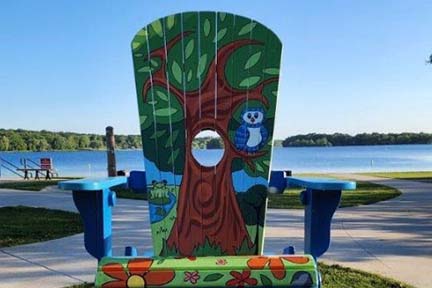
by orionontv | May 30, 2024 | Recreation
FOR IMMEDIATE RELEASE
May 30, 2024
Contact: Ron Leix, Treasury, 517-335-2167

A newly installed “Set with Met” giant wooden chair is now available for visitors to use at Kensington Metropark.
Miss Michigan 2023 co-hosts event, speed paints and reads to local children
OAKLAND COUNTY — Pre-school children from a local day care facility shared a newly installed giant wooden chair with 2023 Miss Michigan Maya Schuhknecht during Michigan Education Trust’s “Sit with MET” event Wednesday at Kensington Metropark to promote Michigan’s Section 529 prepaid tuition educational savings plan.
MET Executive Director Diane Brewer kicked off the event, which coincided with National 529 Day, by telling children from Rosebrook Child Development Center in Wixom and parents that “MET wants to help your family and families all over Michigan save money so you and other kids can be whatever they want to be when they grow up.”
She added, “MET wants your families to know that the gift of learning begins with reading in the same way that the gift of education begins with saving for school and there’s no place more fun to read than in a giant chair in the park.”
Since it was signed into law more than 35 years ago as Michigan’s Section 529 prepaid tuition program, MET’s objective has been to help families financially prepare for their children’s educational future by prepurchasing future tuition at today’s rates.
The installation of the oversized Adirondack chair at Kensington Metropark and another one at Lake St. Clair Metropark are part of a new sponsorship arrangement between MET and Huron-Clinton Metroparks.
“As we focus on expanding supplemental science learning, field trips and other educational programs through our Metroparks and Me initiative, I am reminded of the similar focus that MET has to expand education opportunities for students in Michigan,” said Jim O’Brien, Metropark’s district superintendent. “We are honored to have MET as one of our sponsors this year and excited to house this giant and creative chair here at Kensington and Lake St. Clair Metropark this summer for visitors to enjoy.”
As part the program, Miss Michigan 2023 Schuhknecht memorialized the unveiling in a painting she created as the children looked on. Schuhknecht is a professional artist and speed painter. She is the first pageant winner to highlight speed painting in the talent portion of the scholarship contest.
“I went to college to become an artist,” Schuhknecht told the children. “I am living my dream and I want all of you and other children to live your dreams with help from the Michigan Education Trust.”
MET is offering financial incentives to new and existing customers from now to May 31, 2024. See rules and eligibility requirements.
Additionally, MET holds events periodically throughout the state to provide attendees the opportunity to purchase a MET contract. Representatives from MET are available at the events to help educate people on the features and benefits of each plan and offer tips to parents, grandparents and others on saving for college. MET also offers one-on-one consultation sessions for those unable to attend one of the events.
Investing with MET
MET contracts can be opened by purchasing as little as one credit hour, and anyone can contribute to a child’s education savings plan, including grandparents, aunts, uncles, friends and others. With a Pay-As-You-Go plan, once the plan is opened, contributions can be as low as $25.
The 529 plan also has tax advantages. For instance, distributions from MET are not taxed by the state or federal government when it comes time to pay for qualified higher education expenses. Michigan residents who are MET contract holders can also claim a state tax deduction on the total contributions they make during a calendar year.
Contributions to an existing account can be made at any time during the year through MET’s secure online pay site. MET gift declarations also allow contributors to print out certificates of their contributions designed for holidays, birthdays, graduations and more that can be put in a card or gift wrapped.
More information about MET is available at www.michigan.gov/setwithmet or 800-MET-4-KID (800-638-4543).
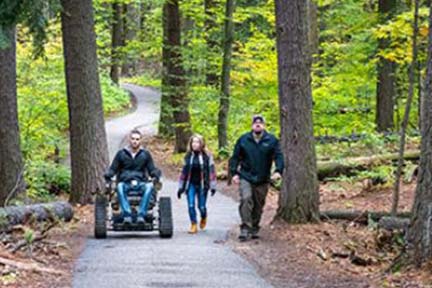
by orionontv | May 29, 2024 | Recreation
|
|
 |
DNR News
|
|
 May 29, 2024 May 29, 2024
Fisheries, trails, parks and more: June meetings welcome public participation, comments
The Department of Natural Resources is committed to providing Michigan residents the opportunity to share input and ideas on policy decisions, programs and other aspects of natural resource management and outdoor recreation opportunities.
One important avenue for this input is at meetings of the public bodies that advise the DNR and, in some cases, also set policies for natural and cultural resource management. Frequently check the DNR boards, commissions, committees and councils webpage for updates.
The links below will take you to the webpage for each group, where you will find meeting details such as location and agenda (when finalized). Please check these pages often, as meeting details may change and sometimes meetings are canceled.
June meetings
- Belle Isle Park Advisory Committee – Thursday, June 20, 9 a.m. (Contact: Barbara Graves, 517-284-6135).
- Coldwater Resources Steering Committee – Wednesday, June 12, 10:30 a.m. (Contact: Addie Myers, 989-778-0389).
- Eastern Upper Peninsula Citizens’ Advisory Council – Wednesday, June 5, 6 p.m. EDT (Contact: Stacy Welling Haughey, 906-226-1331).
- Equine Trails Subcommittee – Wednesday, June 12, 1 p.m. (Contact: Anna Centofanti, 517-331-6219).
- Michigan Historical Commission – Thursday, June 13, 10 a.m. (Contact: Michelle Davis, 517-331-7374).
- Michigan Iron Industry Museum Advisory Board – Tuesday, June 11, 3 p.m. (Contact: Troy Henderson, 906-475-7857).
- Michigan Natural Resources Commission – Thursday, June 13, 9:30 a.m. (Contact: [email protected]).
- Michigan Natural Resources Trust Fund Board – Wednesday, June 12, 9 a.m. (Contact: Jon Mayes, 517-284-5954).
- Michigan State Parks Advisory Committee – Thursday, June 13: (tour) 10 a.m.; (meeting) 12:15 p.m. (Contact: Barbara Graves, 517-284-6135).
- Michigan State Waterways Commission – (tour) Wednesday, June 26, 1 p.m.; (meeting) Thursday, June 27, 9 a.m. (Contact: Michelle Wieber, 517-285-0747).
- Timber and Forest Products Advisory Council – Friday, June 28, 10 a.m. (Contact: Kimberley Korbecki, 517-582-3204).
- Tribal Co-management Citizens Fishery Advisory Committee – Monday, June 24, 6:30 p.m. (Contact: David Caroffino, 231-350-8654).
|
|
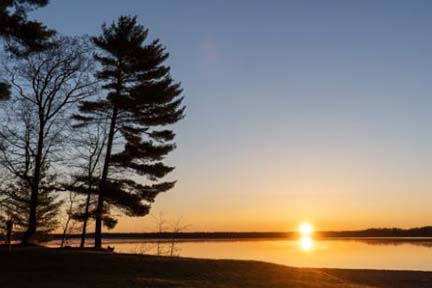
by orionontv | May 23, 2024 | Recreation
|
|
|
|
News Digest – ‘Summer safety’ smarts
Planning a Memorial Day weekend trip? Make sure you’re prepared. Check out safety tips below!
|
| Here are a few of this week’s stories from the Michigan Department of Natural Resources:
See other news releases, Showcasing the DNR stories, photos and other resources at Michigan.gov/DNRPressRoom.
PHOTO FOLDER: Larger, higher-res versions of some of the images used below, and others, are available in this folder.

Summer temperatures are here, and the water is calling! Many state parks, but not all, offer swim areas identified by buoys or markers, a beach flag warning system and water depth less than 5 feet at the time of installation. Before you jump in, make sure to keep safety in mind, especially on big water. Remember the Great Lakes are large, powerful water systems that hold more than 20% of the world’s fresh water. Strong currents can catch even the most experienced swimmer off guard.
To keep everyone safe, follow these must-know tips:
- Check weather conditions and beach flags in buoyed swim areas (double-red flags = water access closed, red flag = high hazard, yellow flag = medium hazard, green flag = low hazard). By law, you cannot enter the water from the beach when double-red flags are flying or if otherwise directed.
- Choose buoyed swim areas located in state parks. Swim areas offer additional safety measures and visual cautions. It’s important to note that not all state parks have designated swim areas.
- Never swim alone, especially children.
- Keep close watch on children and weaker swimmers: Stay within arm’s reach, have them wear U.S. Coast Guard-approved life jackets, be conscious of their limits and take breaks frequently.
- Be aware of water temperatures. Water can be much colder than the ambient air temperature might suggest, especially in larger bodies of water like the Great Lakes. Sudden immersion and/or sustained time in cold water can cause cold shock, making it hard to breathe and increasing your risk of drowning.
Learn more about these beach safety tips, including information about the benefits of buoyed swim areas, the beach flag warning system, how to spot (and escape) Great Lakes currents and more at Michigan.gov/BeachSafety.
|

Summer is the season of grills, campfires, sparklers and fireworks, and with hotter, dryer weather comes fire season. To protect people, wildlife and landscapes, it’s important to follow fire safety tips and be prepared in case your fire does something unpredictable.
Here are some basic safety guidelines:
- When making a campfire, build it in a ring or pit. Never leave a fire unattended, even for a moment. When you’re done, douse your fire thoroughly with water, stir and douse again.
- When using fireworks, keep a hose handy and make sure to soak used sparklers in water before discarding them. Never shoot fireworks into dry grass, brush or trees. When barbecuing, never leave the grill unattended and keep a water source nearby.
- If you are planning work, not play, for your holiday weekend, make sure your yard cleanup is safe. When towing trailers or equipment, ensure tow chains don’t drag and cause sparks, and avoid using heavy machinery like lawnmowers in dry areas. Always keep a water source handy.
- Debris burning is the top cause of wildfires in Michigan. Check whether burn permits are being issued or if weather conditions allow for safe burning before you burn. Check the burn permit page or call 866-922-BURN (866-922-2876) for more information.
- Use firewise landscaping tips at home, too, to maintain a safe space around your house. Trim low branches, remove dead vegetation and keep firewood piles a safe distance away.
Nine out of 10 wildfires are caused by people. If you see a fire grow out of control, call 911 immediately. Swift action can save lives.
For more information, visit Michigan.gov/FireSafety.
|

Off-road vehicles are fun year-round, but ORV activity ramps up in spring and summer as people head to Michigan trails and ORV scramble areas to enjoy world-class riding experiences.
Keeping safety in mind is vital on any ride, for you and others. According to 2023 statewide ORV crash data, 93% of ORV fatalities could have been prevented. These crashes were primarily due to excessive speed and a lack of helmet/seat belt use.
“Always ride within your and the machine’s capabilities,” said Cpl. Mike Hearn, DNR law enforcement ORV and snowmobile specialist. “When operators ride too fast, they are more likely to lose control when they hit even the smallest bump, try to make turns or stop. Riding sober and at a safe speed are the best ways to stay safe.”
All ORV operators are urged to “Ride Right” and keep this important guidance in mind:
- Operate within the limits of your ORV and your own capabilities.
- Ride at a safe speed.
- Ride sober.
- Ride on the right side of the trail.
- Keep lights on when riding.
- Always wear a helmet.
Do your part to ensure everyone returns home safely; read more about ORV safety at Michigan.gov/RideRight. For more on where to ride and ORV laws in Michigan, visit Michigan.gov/ORVInfo.
|

Just in time for the holiday weekend, the DNR and McDonald’s of Michigan are teaming up to encourage young boaters to wear their life jackets this summer.
Now through Labor Day, conservation officers will pass out coupons for a free McDonald’s ice-cream cone or apple slice package (valid at participating McDonald’s locations) to youth boaters who are seen properly wearing a life jacket.
“We’re excited to partner with McDonald’s on this boating safety campaign to remind parents to encourage their children to wear life jackets,” said Lt. Tom Wanless. “It’s easy to get distracted on the water, and making sure your child wears a U.S. Coast Guard-approved life jacket is one of the easiest safety precautions you can take.”
According to the most recent U.S. Coast Guard statistics, 75% of boating deaths are due to drowning, and 85% of those victims were not wearing a life jacket.
If you’re planning to be on or near the water this weekend – or at all this summer – take time before you leave shore to ensure you are prepared for a water emergency:
- Complete an accredited boater safety education program.
- Wear a U.S. Coast Guard-approved life jacket.
- Leave a float plan with someone on shore.
- Boat sober.
- Stay alert for swimmers, wildlife, other boaters, escaped fish nets and debris floating near the surface of the water.
- Make sure your vessel is in good operating condition and pack basic safety gear, including life jackets, a first-aid kit, fire extinguisher, tow rope and anchor.
- Carry a cell phone or marine radio.
- Pack water, snacks and weather-appropriate clothing in case you become stranded.
Keep in mind that current water temperatures throughout the state are still chilly, increasing the risk for hypothermia.
|

The 2024 North American wildfire season is underway and warmer weather is increasing the risk of higher ozone levels.
In case you missed it, the Michigan Department of Health and Human Services is suggesting Michigan residents take steps to protect themselves from risks related to poor air quality.
Monitor the air quality index on the AirNow website, or sign up for alerts through the EnviroFlash system. Keep an eye on the news and weather and be prepared in case of smoke.
Before a wildfire smoke event, MDHHS recommends you:
- Familiarize yourself with your forced air HVAC system or your window air conditioning unit. If it has a fresh-air intake or outdoor air damper, you will need to close it during a smoke event.
- Ensure you have replacement air filters that are rated MERV-13 or higher.
- Consider purchasing a portable air cleaner. If you don’t have one, you can make a do-it-yourself air filter.
- Help neighbors and family members plan for possible wildfire smoke.
- If you have asthma or other respiratory illnesses, heart disease, diabetes or another health condition that may make you more sensitive to wildfire smoke, talk to your health care provider ahead for guidance.
- Children under 18, anyone over the age of 60, pregnant people and outdoor workers are also more at risk. Talk to your health care provider ahead of time to make a plan.
Find more information on the MDHHS Your Health and Wildfire Smoke page. |
 See more pictures by Michigan state parks photo ambassadors at Instagram.com/MiStateParks. For more on the program, call Stephanie Yancer at 989-274-6182. (This photo is by Ryan Burger Devries, for the Michigan DNR, at Grand Haven State Park in Ottawa County). See more pictures by Michigan state parks photo ambassadors at Instagram.com/MiStateParks. For more on the program, call Stephanie Yancer at 989-274-6182. (This photo is by Ryan Burger Devries, for the Michigan DNR, at Grand Haven State Park in Ottawa County).
|
|
A safe cookout starts with safe food practices. Keep food safety tips in mind, especially around cleaning, storage and cooking preparation.
|
|
Many outdoor recreation opportunities require a safety certificate; check out available safety and education programs to brush up on your safety skills.
|
|
|












